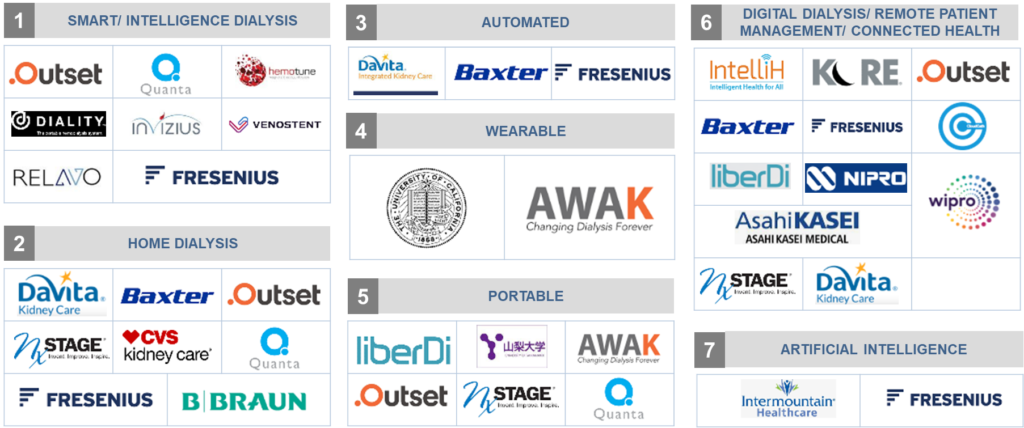Advancements and Trends in Dialysis
The global dialysis trends market is currently valued at around $84 billion and is expected to grow to $98 billion by 2025. The increasing prevalence of chronic kidney disease (CKD), currently estimated to affect around 850 million people worldwide, is a key driver of this growth. CKD is a major public health problem due to its high prevalence and associated mortality.
In the US alone, CKD is the ninth leading cause of death, with an estimated annual cost of $51 billion. The good news is that, thanks to advances in medical technology, the mortality rate from CKD has been falling in recent years. However, the number of people living with CKD is still rising, due to the aging population and the increasing prevalence of risk factors such as diabetes and hypertension. This means that the demand for dialysis is also likely to continue to grow in the coming years.
In the past, dialysis was a very invasive and time-consuming process, involving the use of large machines and a lot of manual labor. However, the introduction of new technologies is transforming dialysis, making it more efficient and less invasive. One of the most important innovations in dialysis is the introduction of portable dialysis machines. These allow patients to receive dialysis at home, or even while they are traveling. Another major development is the use of artificial intelligence (AI) in dialysis. Furthermore, AI is being used to develop more personalized treatment plans for patients, as well as to monitor their condition and predict when they may need dialysis.

The peritoneum is filled with a special solution, and the patient’s blood is pumped through the peritoneum. Patients benefit from the ability to perform this type of dialysis at home, which reduces the risk of infection compared to other dialysis methods.
- Hemodialysis: It is another type of dialysis that uses an artificial kidney, or dialyzer, to filter the blood. The advantage of this type of dialysis is that it can be done at a hospital or outpatient center. The disadvantage is that it is more expensive than peritoneal dialysis and requires more frequent visits to the center.
The major two types of dialysis machines are:
- The most common type is the continuous ambulatory peritoneal dialysis machine. This machine is small and portable, and it can be used at home. The advantage of this machine is that it is less expensive than the other types of dialysis machines. The disadvantage is that it is not as effective as the other types of machines.
- The next type of dialysis machine is the hemodialysis machine. This machine is larger and more expensive than the continuous ambulatory peritoneal dialysis machine. The advantage of this machine is that it is more effective than the other types of machines. The disadvantage is that it requires more frequent visits to the center.
- The last type of dialysis machine is the home hemodialysis machine. This machine is the most expensive and the most effective. The advantage of this machine is that it can be used at home. The disadvantage is that it requires more frequent visits to the center.
There are many other types of dialysis and new technologies that are always emerging. The future of dialysis is likely to be increasingly digital. This will bring many benefits for patients, including more personalized treatment, improved access to care, and lower costs. Every day technologies are advancing in this domain.
Technology Advancements in Hemodialysis:
- Smart Device Haemodialysis Ubiplug, a France based startup developing smart valves to ease hemodialysis for patients with end-stage renal disease. The developing smart valve allows nurses to switch session steps without having to open the catheter. The smart valve eliminates the manipulations nurse make while handling Luer Lock, hence minimizing infections. Smart valve makes the Central Venous Catheter process easier and improves ergonomics. Ubiplug grew in collaboration with CHU Caen, AP-HP, and Air Liquide Healthcare. Ubiplug has raised $4.5M in VC and corporate financing, EU funding, and regional grants.
- Wearable Vein Dilation: Fist Assist Devices, is developing a device to make a patient’s vein bigger to hold a dialysis catheter. The device has a balloon that inflates and deflates to enhance the vein’s size. The device is to be worn o the arm and powered by batteries. In addition, Fist Assist has started raising $2.5 million in partnership with KorConx. According to the company, 90% of the fund would be used to invest in sale marketing.
- Custom fit Vascular wrap stent: VenoStent aims to improve dialysis patient outcomes. VenoStent is developing a vascular wrap that is flexible, durable and custom fit. Its design aims to decrease failure at the junction of veins and arteries and prevent vein collapse by promoting the outward growth of veins. VenoStent has won KidneyX Prize and has raised $2.4 million in funding.
- Compact flexible hemodialysis system: Quanta, is developing a compact, advanced, and lightweight dialysis system for homes and clinics. Additionally, it has a cloud-based digital health function to automate data capture and reporting. Quanta has raised close to $245 million in funding
Dialysis Trends: Technological Advancements in Peritoneal Dialysis
- Wearable dialysis machine, AWAK, a patient-centric technology company focusing on dialysis management. The company’s innovative portable wearable technology in dialysis machines minimalizes the progression of kidney dialysis. With AWAK technology, patients need lesser liquid management about 85 percent than the traditional dialysis solutions for hemodialysis or peritoneal dialysis. AWAK’s sorbent technology enables a reduction in fresh dialysate and also miniaturizes the dialysis system.
- Low cost Dialysate Preparation: Ellen Medical Devices, is developing a Point of care dialysis system to create peritoneal dialysis fluid, which can be affordable everywhere around the world. A preliminary tested product has low-cost solution for dialysis. The device sterilizes water from any source to produce peritoneal dialysis fluid. Additionally, the device has patented small, pure water distillers to produced water which met the standards suitable for use in the dialysis fluid.
- Remote Monitoring of Kidney Health: US based Cloudcath, provides a sensor-enabled device and a digital platform. The real-time monitoring platform detects early stage risk to peritoneal dialysis patients through home based treatment. Moreover, the device evaluates draining fluid to extract data and map a patient’s kidney health.
- Internal Disinfection: Revalo, a company founded by graduates of Johns Hopkins, provides solutions for peritoneal dialysis by disinfecting the peritoneal dialysis device system. Revalo is developing a device named PeritoneX®, an in-line connection device that disinfects dialysis tubes at all connection sites.
The future of dialysis therapy looks very promising. Ongoing research and development in dialysis lead to improved survival rates for patients undergoing treatment.
Additional Advancements
- One of the most exciting recent developments is the use of miniaturized artificial kidneys. Implantable devices directly placed within the patient’s body offer enhanced blood filtration capabilities compared to conventional dialysis machines. Researchers are currently conducting clinical trials to evaluate the safety and effectiveness of these devices, which, if successful, have the potential to revolutionize the dialysis procedure.
- Other promising developments include the use of stem cells to repair damaged kidneys, and the development of new drugs that can help the kidneys function more effectively. Researchers are also working on ways to improve the quality of life for patients on dialysis, such as developing new methods of providing dialysis at home. Overall, the future of dialysis therapy looks very bright. Continuous advancements in dialysis techniques are enabling an increasing number of individuals to lead longer and healthier lives.
- Alio and Lifeline Vascular Care are partnering for end stage renal disease support. Alio’s AI and SmartPatch technology is expected to reduce potential complications and improve dialysis care team efficiency. Lifeline’s patient and lab and ambulatory network will provide support to Alio remote monitoring system. Also, the partnership will create opportunities in in the treatment of dialysis vascular access management and peripheral arterial disease (PAD).
- New York based startup Qidni Labs is developing waterless and mobile blood purification system. The startup is developing a hemodialysis machine that utilizes its own cartridge and gel-based system to reduce the water requirement for dialysis. Moreover, in 2019 Qidni Labs was a winner at 2019 KidneyX Summit for developing an air removal system for a wearable renal therapy device.
- Hometune is developing a blood purification device for the removal of disease-causing substances from the bloodstream of a patient. It targets a broad range of harmful compounds such as toxins, pathogenic organisms, or overdosed drugs.
- Invizius is developing a solution for hemodialyzer made up of a hemocompatible coating capable of preventing the blood’s foreign body reactions during dialysis. Hollow fibers in the dialyzers reduce the inflammation of the membrane in the patient’s blood.
- Digitalization is also having an impact on the way dialysis is delivered. There is a growing trend towards ‘tele-dialysis’, where patients can receive treatment remotely, via video conferencing. This has the potential to greatly improve access to dialysis, particularly in rural and remote areas.
Conclusion
There is a need for more personalized (home-based) and sustainable dialysis treatment in the future, with a clear focus on cardio protection and volume management. The development of specialized transition clinics to guide patients through the vulnerable period of starting dialysis, personalized programs for exercise training, and the introduction of wearable electronic health devices may help the kidney community to achieve this goal.
The document covers:
- Overview
- Hemodialysis
- Peritoneal Dialysis
- Pain Pointers and Solutions
- Our Research in Urology
- Stellarix’s Assistance



